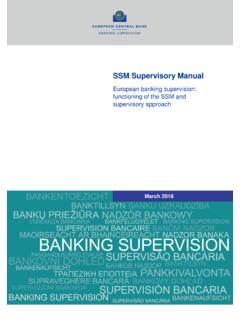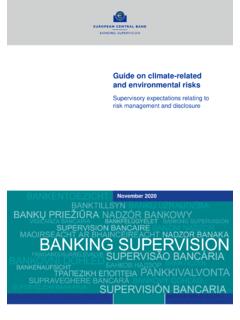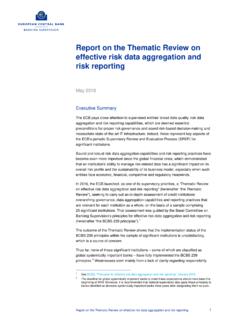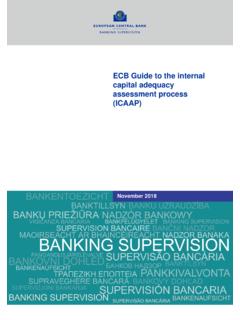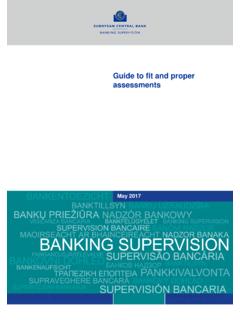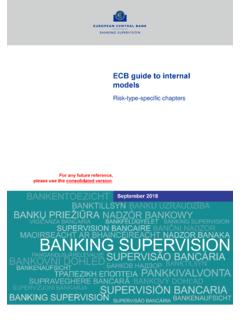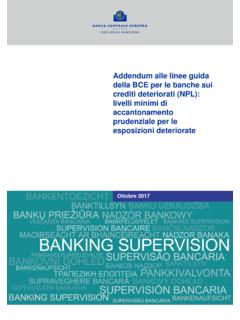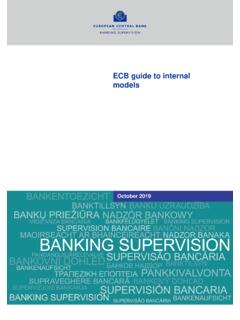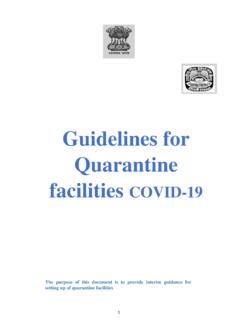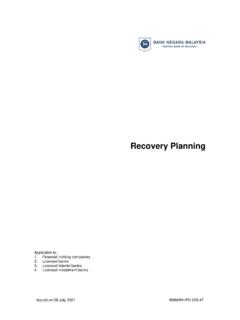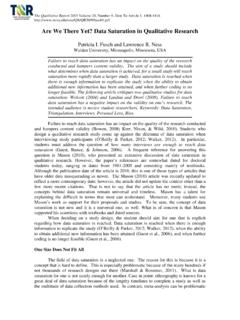Transcription of Guidance to banks on non-performing loans - Europa
1 ECB-RESTRICTED (until PUBLIC) Guidance to banks on non -performing loans March 2017 Guidance to banks on non-performing loans 1 Contents 1 Introduction 4 Context of this Guidance 4 Applicability of this Guidance 5 Scope of this Guidance 6 Structure 7 2 NPL strategy 8 Purpose and overview 8 Assessing the operating environment 8 Developing the NPL strategy 12 Implementing the operational plan 15 Embedding the NPL strategy 16 supervisory reporting 17 3 NPL governance and operations 18 Purpose and overview 18 Steering and decision making 18 NPL operating model 19 Control framework 27 Monitoring of NPLs and NPL workout activities 29 early warning mechanisms/watch-lists 35 supervisory reporting 38 4 Forbearance 39 Purpose and overview 39 Forbearance options and their viability 39 Sound forbearance processes 44 Affordability assessments 45 supervisory reporting and public disclosures 46 Guidance to banks on non-performing loans 2 5 NPL recognition 47 Purpose
2 And overview 47 Implementation of the NPE definition 49 Link between NPEs and forbearance 54 Further aspects of the non-performing definition 59 Links between regulatory and accounting definitions 61 supervisory reporting and public disclosures 63 6 NPL impairment measurement and write-offs 65 Purpose and overview 65 Individual estimation of provisions 67 Collective estimation of provisions 74 Other aspects related to NPL impairment measurement 78 NPL write-offs 79 Timeliness of provisioning and write-off 81 Provisioning and write-off procedures 82 supervisory reporting and public disclosures 85 7 Collateral valuation for immovable property 86 Purpose and overview 86 Governance, procedures and controls 87 Frequency of valuations 90 Valuation methodology 91 Valuation of foreclosed assets 95 supervisory reporting and public disclosures 97 Annex 1 Glossary 98 Annex 2 Sample of NPL segmentation criteria in retail 101 Annex 3 Benchmark for NPL monitoring metrics 104 Annex 4 Samples of early warning indicators 106 Annex 5 Common NPL-related policies 108 Guidance to banks on non-performing loans 3 Annex 6 Affordability assessment for retail and corporate borrowers 114 Annex 7 Summary of supervisory reporting and disclosures related to NPLs 119 Annex 8 Risk transfer of NPLs 129 ECB-RESTRICTED (until PUBLIC) Guidance to banks on non-performing loans Introduction 4 1 Introduction Context of this Guidance A number of banks in Member States across the Euro area are currently experiencing high levels of non-performing loans (NPLs), as shown in Figure 1.
3 There is broad consensus on the view that high NPL levels ultimately have a negative impact on bank lending to the economy1, as a result of the balance sheet, profitability, and capital constraints faced by banks with high NPL levels. Figure 1 Texas ratio and Impaired loan ratio evolution in the euro area Impaired loan ratios for euro area significant banking groups (2007-2015; percentage of loans , median values) Source: SNL Financial. Notes: Based on publicly available data for a sample of 55 significant banking groups. Countries most affected by the crisis include Cyprus, Greece, Ireland, Italy, Portugal, Slovenia and Spain. The deliberate and sustainable reduction of NPLs in banks balance sheets is beneficial to the economy from both a microprudential and a macroprudential perspective. At the same time, it is acknowledged that economic recovery is also an important enabler of NPL resolution. Addressing asset quality issues is one of the key priorities for European Central Bank (ECB ) banking supervision.
4 The ECB s focus on this issue began with the 2014 comprehensive assessment, which comprised two main pillars an asset quality review and a stress test. Subsequent to the comprehensive assessment, ECB banking supervision continued to intensify its supervisory work on NPLs. In the context of on-going supervisory engagement, the joint supervisory teams (JSTs) 1 See ECB and other international research, International Monetary Fund (IMF) discussion note Strategy for Resolving Europe s Problem loans 0246810121420072008200920102011201220132 0142015countries most affected by the financial crisisother countriesall countriesRatio of non-performing loans to tangible equity and loan loss reserves for euro area significant banking groups (2007-201 5; percentages; median values) Source: SNL Financial. Notes: Based on publicly available data for a sample of significant banking groups. Countries most affected by the financial crisis are Cyprus, Greece, Ireland, Italy, Portugal, Slovenia and Spain.
5 0204060801001202007200820092010201120122 01320142015countries most affected by the financial crisisother countriesGuidance to banks on non-performing loans Introduction 5 have observed varying approaches by banks to the identification, measurement, management and write-off of NPLs. In this regard, in July 2015 a high-level group on non- performing loans (comprising staff from the ECB and national competent authorities) was mandated by the supervisory Board of the ECB to develop a consistent supervisory approach to NPLs. Furthermore, in its supervisory priorities, ECB banking supervision has highlighted credit risk and heightened levels of non-performing loans as key risks facing euro area banks . Through the work of the high-level group, ECB banking supervision has identified a number of best practices that it deems useful to set out in this public Guidance document. These practices are intended to constitute ECB banking supervision's supervisory expectation from now on. This Guidance contains predominantly qualitative elements.
6 The intention is to extend the scope of the Guidance based on the continuous monitoring of developments concerning NPLs. As a next step in this regard, the ECB plans to place a stronger focus on enhancing the timeliness of provisions and write-offs. While it is acknowledged that addressing non-performing loans will take some time and will require a medium-term focus, the principles identified will also serve as a basic framework for conducting the supervisory evaluation of banks in this specific area. As part of their ongoing supervisory work, the JSTs will engage with banks regarding the implementation of this Guidance . It is expected that banks will apply the Guidance proportionately and with appropriate urgency, in line with the scale and severity of the NPL challenges they face. Applicability of this Guidance This Guidance is addressed to credit institutions within the meaning of Article 4(1) of Regulation (EU) 575/2013 (CRR)2, hereinafter named banks . It is generally applicable to all significant institutions (SIs) supervised directly under the Single supervisory Mechanism (SSM), including their international subsidiaries.
7 However, the principles of proportionality and materiality apply. Hence, parts of this document, namely chapters 2 and 3 on NPL strategy, governance and operations, may be more relevant for banks with high levels of NPLs ( h igh NPL banks ) that need to deal with this extraordinary situation. Nonetheless, SIs with a relatively low overall level of NPLs might still find it useful to apply certain parts of those chapters, to high NPL portfolios. Chapters 4, 5, 6 and 7 are considered applicable to all SIs. For the purpose of this Guidance , the ECB s banking supervision defines high NPL banks as banks with an NPL level that is considerably higher than the EU average 2 Regulation (EU) No 575/2013 of the European Parliament and of the Council of 26 June 2013 on prudential requirements for credit institutions and investment firms and amending Regulation (EU) No 648/2012 (OJ L 176, , p. 1). Guidance to banks on non-performing loans Introduction 6 However, this definition is highly simplified and banks not falling under its terms might still benefit from applying the full content at their own initiative or on request by supervisors, especially in the case of significant NPL inflows, high levels of forbearance or foreclosed assets, low provision coverage or an elevated Texas ratio4.
8 This NPL Guidance is currently non-binding in nature. However, banks should explain and substantiate any deviations upon supervisory request. This Guidance is taken into consideration in the SSM regular supervisory Review and Evaluation Process and non- compliance may trigger supervisory measures. This Guidance does not intend to substitute or supersede any applicable regulatory or accounting requirement or Guidance from existing EU regulations or directives and their national transpositions or equivalent, or guidelines issued by the European Banking Authority (EBA). Instead, the Guidance is a supervisory tool with the aim of clarifying the supervisory expectations regarding NPL identification, management, measurement and write-offs in areas where existing regulations, directives or guidelines are silent or lack specificity. Where binding laws, accounting rules and national regulations on the same topic exist, banks should comply with those. It is also expected that banks do not enlarge already existing deviations between regulatory and accounting views in the light of this Guidance , but rather the opposite: whenever possible, banks should foster a timely convergence of regulatory and accounting views where those differ substantially.
9 This Guidance should be applicable as of its date of publication. SIs may, however, close identified gaps thereafter based on suitable time-bound action plans which should be agreed with their respective JSTs. In order to ensure consistency and comparability, the expected enhanced disclosures on NPLs should start from 2018 reference dates. Scope of this Guidance NPLs is generally used in this Guidance as a shorthand term. However, in technical terms, the Guidance addresses all non-p erforming exposures (NPEs), following the EBA definition5, as well as foreclosed assets, and also touches on performing exposures with an elevated risk of turning non-performing , such as watch-list exposures and performing forborne exposures. NPL and NPE are used interchangeably within this Guidance . 3 A suitable reference to determine EU average NPL ratios and coverage levels is the quarterly published European Banking Authority (EBA) risk dashboard.
10 4 Definitions of different concepts used in this Guidance can be found in the Glossary in Annex 1. 5 See chapter 5 for details. Guidance to banks on non-performing loans Introduction 7 Structure The document structure follows the life cycle of NPL management. It starts with the supervisory expectations on NPL strategies in chapter 2, which closely link to NPL governance and operations, covered in chapter 3. Following this, the Guidance outlines important aspects for forbearance treatments, in chapter 4, and NPL recognition, in chapter 5. Qualitative Guidance on NPL provisioning and write-off is treated in chapter 6 while collateral valuations are addressed in chapter 7. Guidance to banks on non-performing loans NPL strategy 8 2 NPL strategy Purpose and overview An NPL strategy establishes strategic objectives for high NPL banks for the time-bound reduction of NPLs over realistic but sufficiently ambitious time-bound horizons (NPL reduction targets). It should lay out the bank s approach and objectives regarding the effective management ( maximisation of recoveries) and ultimate reduction of NPL stocks in a clear, credible and feasible manner for each relevant portfolio.
